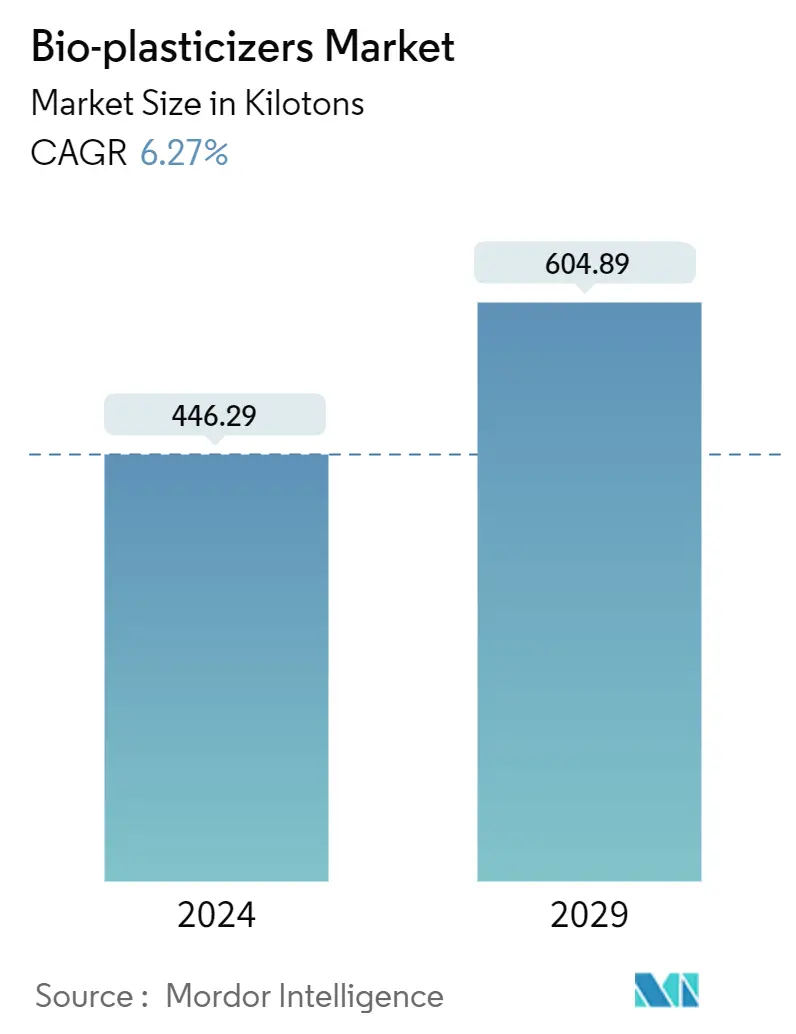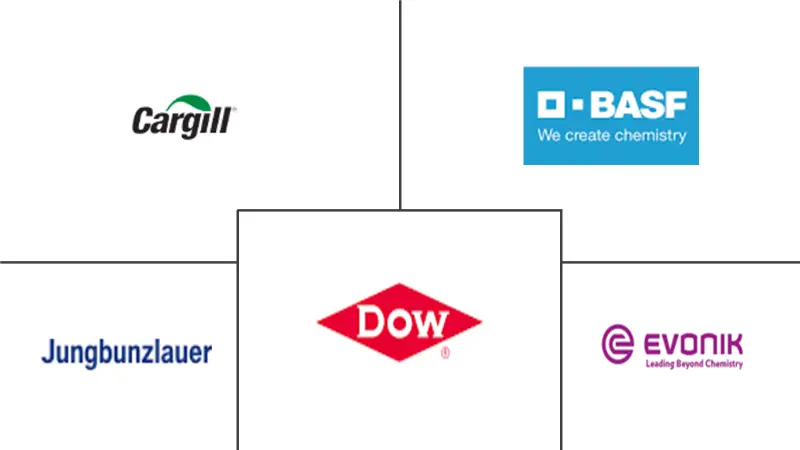Market Size of Bio-plasticizers Industry

| Study Period | 2019 - 2029 |
| Market Volume (2024) | 446.29 kilotons |
| Market Volume (2029) | 604.89 kilotons |
| CAGR (2024 - 2029) | 6.27 % |
| Fastest Growing Market | Europe |
| Largest Market | Asia-Pacific |
| Market Concentration | High |
Major Players
*Disclaimer: Major Players sorted in no particular order |
Bio Plasticizers Market Analysis
The Bio-plasticizers Market size is estimated at 446.29 kilotons in 2024, and is expected to reach 604.89 kilotons by 2029, growing at a CAGR of 6.27% during the forecast period (2024-2029).
COVID-19 negatively impacted the market in 2020. During the pandemic, construction activities were temporarily halted due to the government-imposed lockdown. This led to a decrease in the consumption of bio-plasticizers based on flooring and wall coverings, wires, and cables, which, in turn, negatively impacted the demand for bio-plasticizers. However, the demand for packaging from the food and e-commerce segment significantly increased during this situation, which, in turn, stimulated the demand for packaging materials made up of bio-plasticizers, thus enhancing the market growth.
- Over the short term, the augmenting demand for bio-plasticizers for flexible PVC and the prohibition on phthalate-based plasticizers are expected to drive the growth of the market.
- The high cost of bio-plasticizers, when compared with conventional plasticizers, is likely to hinder the growth of the market.
- Ongoing research on bio-based plasticizers is likely to create opportunities for the market during the forecast period.
- The Asia-Pacific region is expected to dominate the market. It is also likely to witness the highest CAGR during the forecast period.
Bio Plasticizers Industry Segmentation
Bio-plasticizers are polymer materials derived from renewable sources, including vegetable oil and biomass. It can be considered a substitute for polyvinyl chloride (PVC). It finds its major application in end-user industries, including building and construction, electronics, and automotive.
The market is segmented by type, application, and geography. By type, the market is segmented into epoxidized soybean oil, castor oil, citrates, succinic acid, and other types. By application, the market is segmented into wire and cables, film and sheet, flooring, roofing, wall coverings, medical devices, consumer goods, and other applications. The report also covers the market sizes and forecasts for bio-plasticizers in 15 countries across major regions. For each segment, the market sizes and forecasts have been done in terms of volume (tons).
| By Type | |
| Epoxidized Soybean Oil (ESBO) | |
| Castor Oil | |
| Citrates | |
| Succinic Acid | |
| Other Types |
| By Application | |
| Wire and Cables | |
| Film and Sheet | |
| Flooring, Roofing and Wall Covering | |
| Medical Devices | |
| Consumer Goods | |
| Other Applications |
| By Geography | |||||||
| |||||||
| |||||||
| |||||||
| |||||||
|
Bio-plasticizers Market Size Summary
The bio-plasticizers market is poised for significant growth over the forecast period, driven by increasing demand for environmentally friendly alternatives to traditional plasticizers. The market is experiencing a resurgence as industries seek to reduce their environmental footprint, particularly in sectors like construction and packaging. The shift away from phthalate-based plasticizers due to regulatory pressures is further propelling the adoption of bio-plasticizers, especially in applications such as flexible PVC. Despite the high cost compared to conventional options, ongoing research and development in bio-based plasticizers are expected to create new opportunities, enhancing market dynamics. The Asia-Pacific region is anticipated to lead the market, benefiting from robust construction activities and a growing middle class, which are contributing to increased demand for bio-plasticizers in various applications.
The impact of the COVID-19 pandemic initially posed challenges to the bio-plasticizers market, with disruptions in construction activities leading to a temporary decline in demand. However, the surge in demand for packaging materials, particularly in the food and e-commerce sectors, provided a counterbalance, supporting market growth. The construction industry's recovery, especially in countries like China and India, is expected to drive further demand for bio-plasticizers, as these materials are increasingly used to enhance the performance of concrete and other building materials. Additionally, the packaging industry in India is emerging as a significant growth area, with government initiatives and foreign investments bolstering the sector. The market's partially consolidated nature, with key players like Dow, Evonik Industries AG, and BASF SE, continues to influence competitive dynamics, as companies expand their product offerings and geographic reach to capitalize on growing demand.
Bio-plasticizers Market Size - Table of Contents
-
1. MARKET DYNAMICS
-
1.1 Drivers
-
1.1.1 Increasing Demand for Flexible PVC
-
1.1.2 Stringent Phthalate Regulations to Boost the Use of Bio-Plasticizers
-
-
1.2 Restraints
-
1.2.1 Availability of Alternatives to bio-plasticizers
-
1.2.2 Other Restraints
-
-
1.3 Industry Value Chain Analysis
-
1.4 Porter's Five Forces Analysis
-
1.4.1 Bargaining Power of Suppliers
-
1.4.2 Bargaining Power of Consumers
-
1.4.3 Threat of New Entrants
-
1.4.4 Threat of Substitute Products and Services
-
1.4.5 Degree of Competition
-
-
-
2. MARKET SEGMENTATION (Market Size in Volume)
-
2.1 By Type
-
2.1.1 Epoxidized Soybean Oil (ESBO)
-
2.1.2 Castor Oil
-
2.1.3 Citrates
-
2.1.4 Succinic Acid
-
2.1.5 Other Types
-
-
2.2 By Application
-
2.2.1 Wire and Cables
-
2.2.2 Film and Sheet
-
2.2.3 Flooring, Roofing and Wall Covering
-
2.2.4 Medical Devices
-
2.2.5 Consumer Goods
-
2.2.6 Other Applications
-
-
2.3 By Geography
-
2.3.1 Asia-Pacific
-
2.3.1.1 China
-
2.3.1.2 India
-
2.3.1.3 Japan
-
2.3.1.4 South Korea
-
2.3.1.5 Rest of Asia-Pacific
-
-
2.3.2 North America
-
2.3.2.1 United States
-
2.3.2.2 Canada
-
2.3.2.3 Mexico
-
-
2.3.3 Europe
-
2.3.3.1 Germany
-
2.3.3.2 United Kingdom
-
2.3.3.3 Italy
-
2.3.3.4 France
-
2.3.3.5 Rest of Europe
-
-
2.3.4 South America
-
2.3.4.1 Brazil
-
2.3.4.2 Argentina
-
2.3.4.3 Rest of South America
-
-
2.3.5 Middle East and Africa
-
2.3.5.1 Saudi Arabia
-
2.3.5.2 South Africa
-
2.3.5.3 Rest of Middle East and Africa
-
-
-
Bio-plasticizers Market Size FAQs
How big is the Bio-plasticizers Market?
The Bio-plasticizers Market size is expected to reach 446.29 kilotons in 2024 and grow at a CAGR of 6.27% to reach 604.89 kilotons by 2029.
What is the current Bio-plasticizers Market size?
In 2024, the Bio-plasticizers Market size is expected to reach 446.29 kilotons.

